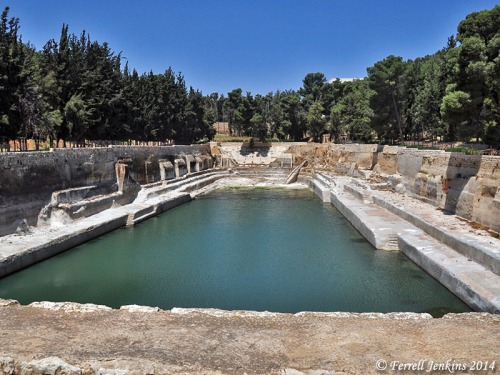It is a fact that numerous structures in Israel are incorrectly identified. Earlier travelers may have asked where this or that biblical event took place. There was always someone willing to show them what they wanted to see. Some items that come to mind include the Tower of David and Solomon’s Stables in Jerusalem, Ahab’s Palace at Jezreel, and Solomon’s Pools southwest of Bethlehem.
In the earliest days of my tours we were able to visit Solomon’s Pools as we traveled between Bethlehem and Hebron. In more recent years the Pools have been in the Palestinian Authority’s West Bank. This means going to Bethlehem and then making arrangement to visit the pools.
Solomon, who ruled about 970–931 B.C., is said to have developed vineyards, gardens, and pools.
I made great works. I built houses and planted vineyards for myself. I made myself gardens and parks, and planted in them all kinds of fruit trees. I made myself pools from which to water the forest of growing trees. (Ecclesiastes 2:4-6 ESV)
These pools do not belong to the time of Solomon. It may be legendary, but Josephus says that Solomon used to ride upon a chariot to a place called Etham (Etam). This area is described as “very pleasant in its fine gardens, and abounding in rivulets of water; he used to go there in the morning sitting high in his chariot” (Antiquities 8:186).
One of the earliest projects conducted by Amihai Mazar, in 1968, was a survey of the 70 kilometers of aqueducts. He wanted to see how accurate Conrad Schick has been in his 19th century surveys.
Several springs feed into the “pools of Solomon” from the south through two aqueducts. From the western pool a high level aqueduct carried water to the Upper City of Jerusalem. From the easternmost pool a low level aqueduct carried water to the Temple Mount.
One of the earliest projects conducted by Amihai Mazar, now Professor Emeritus at Hebrew University, in 1968 was a survey of 70 kilometers of aqueducts. He wanted to see how accurate Conrad Schick had been in his surveys in the 19th century. He says the pools,
must date to the Hasmonean period, perhaps to Alexander Jannaeus [126 B.C.–76 B.C.]. We don’t have any written sources, and there is no objective archaeological data for dating them. But we base our assumption on the fact that in the Mishnah the aqueducts are referred to and are very important for ritual purposes on the Temple Mount. (BAR, 10:3, May/June 1984).
Mazar’s study of “The Aqueducts of Jerusalem” is published in Jerusalem Revealed: Archaeology in the Holy City 1968–1974. 79-84.
Our first photo shows the highest of the pools which I am calling the western pool.
The middle pool is shown here with a view to the northwest. You can see the higher hills in the break between the trees.
The third pool (eastern) is shown below with a view toward the west.
A recent study of “Jerusalem’s Ancient Aqueduct System” by Tom Powers is available for download at his website here. This article can be helpful for those who wish to know more about the subject.
Jerome Murphy-O’Connor has a few pages devoted to Solomon’s Pools, including the aqueduct system, in The Holy Land (483-486).
Within the past few weeks there has been some information, and some unfounded speculation, about a water system found at ‘Ain Joweizeh. Todd Bolen describes the location of the site:
The site is located 5.5 miles (9 km) southwest of the Old City of Jerusalem, 3.5 miles (5.5 km) northwest of Bethlehem, and just down the slope to the west of Har Gilo.
Bolen has a good summary of what we know about this water system (“Royal Water System Excavated in Judean Hills”) in a recent post here.
BAR’s Bible History Daily includes photos of the Proto-Aeolic Capital associated with the recently discovered tunnel here.




Pingback: Anger or Victim? - dbobstoner
Pingback: U.S.A. helping restore the Pools of Solomon | Ferrell's Travel Blog
Pingback: Bethlehem and the birth of Jesus – Index of articles | Ferrell's Travel Blog
Pingback: Historical treasure neglected in Palestinian territory | Ferrell's Travel Blog
Pingback: Index of articles on Bethlehem and the Birth of Jesus | Ferrell's Travel Blog
Beautiful photos! I am glad I stumbled across your blog I have been looking for something about biblical archaeology!
Ferrell, many thanks for pointing folks to my article. I don’t think I was familiar with Josephus’ reference to “Etham” in connection to Solomon. As you may know, the name “Eitan” is today applied to the spring near the lower, easternmost pool, as well as to the prominent hill not far to the east. Moreover, the name of the Palestinian village just down the valley, Artas (or Urtas) is said to derive from “hortus conclusus”, the “enclosed garden” of Song 4:12 — another seeming Solomon connection for the area. I would love to know the history of the place-name Etham/Eitan and also of the (false) attribution of the pools to Solomon. More homework (sigh)…
TOM POWERS / Waynesville, NC